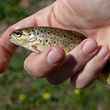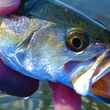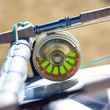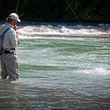We’ve all heard of the “hopper-dropper,” the ubiquitous, two-fly method for summer trout all over the world. But what about the “popper-dropper” for bass, panfish and other warmwater fish? Well, it’s a thing, and I can attest to its effectiveness.
A couple of years ago, while fishing in the Big Thicket National Preserve in southeast Texas, I was introduced to the method, and I’ve used it a few times since in places like north Florida and even in eastern Idaho, where we have something of an unknown, but robust, population of smallmouths in the Snake River.
Bass and sunfish in moving water
Summer bass, and even larger panfish, like bluegills and other sunfish, love to eat topwater flies. Poppers and gurglers are great fly patterns for predatory warmwater fish that look to the top for everything from frogs and small snakes to salamanders, crickets, Junebugs, grasshoppers and crane flies. A loud popper or gurgler will often attract the attention of bass and sunfish, but it’s not always enough to entice an eat.
Next time you’re after bass, particularly bass in moving water — even if it's slow and froggy — try a popper. If you don’t get immediate results, consider attaching a smaller fly, like a Bluegill Spider or a Bream Killer, about 18 inches below the popper (or a Gurgler, for that matter). With every pop or gurgle, the bug beneath the top fly will rise quickly in the water column and then rapidly descend.
On a murky little creek deep in the piney woods of the Big Thicket, I dropped a size 12 Bluegill Spider under a bright chartreuse Gurgler, and drifted both bugs over structure – mostly downed timber, but it worked up against muddy bluffs, too. The catch ratio definitely favored the dropper, but, the popper or Gurgler was absolutely necessary to the equation. A simple drifted Bluegill Spider or Bream Killer dead-drifted under an indicator failed to attract a single strike–a slap in the face for a die-hard trout angler who was convinced that trout were tougher to catch and perhaps a bit more noble than the bourgeois bass and bream.
Saltwater roots
Years ago, while fly fishing on Lake Pontchartrain (while my host for the trip was throwing casting gear and killing it for redfish and speckled trout), I witnessed the utter effectiveness of the popping cork equipped with a live minnow “dropped” below the bobber. My spincasting friend was able to throw 100-foot casts over the lake’s ample shallows, and, with a quick jerk of the rod, the cork would do exactly what it was supposed to do–raise hell on the surface. Below, the hapless minnow battling for survival on the hook, would rise quickly and then descend just as fast.
Sometimes it took a “pop” or two, but often, a big redfish or speckled trout would grab the minnow and my friend would continue his string of dominance.
When I tried the popper-dropper method in Texas, this anecdote came immediately to mind – the ruckus raised by the topwater fly is what turns the heads of the bass and bream. But often, the first thing the fish see is the trailing fly as it rises and falls in the water column.
Taking the show on the road
After witnessing the success of the popper-dropper rig in the murky, snake-infested waters of the Big Thicket, I took the new-to-me method home with me to Idaho. Later that fall, I tried a Gurgler on the Snake River downstream of American Falls, where bass numbers continue to blossom. Beneath the Gurgler I dropped a small Mickey Finn — a clear baitfish imitation. And the bass loved it.
Then, while fishing the Okefenokee National Wildlife Refuge on the border with Georgia and Florida this past spring, I tried a similar method with a big frog Gurgler trailed by a small, yellow fly the locals call a Yellow Sally (kind of a small Woolly Bugger). I caught a couple of warmouth sunfish, but I also picked up chain pickerel and a few bowfin — including one that was more than 30 inches long and probably more than eight pounds.
Create chaos
The lesson, of course, is that predators look for conflict, because conflict creates opportunity. A popper or Gurgler will often attract fish, although the attraction clearly doesn’t always result in a hookup or even a strike. By having a trailing fly beneath the topwater offering, you’re giving the interested fish something to think about, should they opt not to go after the source of the commotion.
The setup is simple. For bass and panfish, you rarely need more than 18 inches of 2x or 3x tippet attached at the bend of the hook of the popper or Gurgler. Don’t go with a heavy dropper, like a fully-leaded Clouser — instead, consider a smaller fly that might imitate small baitfish, like a small Lightning Bug, Mickey Finn or even a shiny Copper John..
Visibility is key – in murky water, like the creek I fished in East Texas, it pays to go with something the fish can pick out through the stained water. A little flash is a prerequisite, and something that moves water is a clear bonus.
When fishing the rig, don’t fish it like you might normally fish a popper or Gurgler on its own. Instead, use the current to get a drift, and do a pop or a gurgle periodically, even if you don’t actually retrieve the topwater fly at all. The idea is to create some chaos and then benefit from the chaos when a predatory fish comes to check it out.
Final word
These days, the hopper-dropper method is the go-to searching option for trout anglers, particularly when they are getting to know new water. The two-fly offering is meant to improve the chances of finding and catching fish.
For warmwater fish, the popper-dropper rig does the same thing, but with a bit of gusto. It's an active method used to entice fish, and it's a great way to cover moving water.
Next time you're out for bass (or bream, pickerel, bowfin or far, consider wreaking a little havoc. Give the popper-dropper method a shot and see if you can't tangle with more fish.






























Comments
Ralston Heath replied on Permalink
I use this method alot. Here in southern Florida, the blue gill stay down to avoid alligators. So a spider followed by an sinking Adams will help you catch something almost every cast. Great for when you are taking new people out for some fishing. They get hooked on fishing. (Pun intended)
Paul Prosser replied on Permalink
I was introduced to this approach years ago by Steve Hollenshed, a striper guide on Lake Texoma (the lake has a native population of stripers). He would employ a big clunky bass popper or big hair bug on the surface, and below it he would suspend a medium-sized Woolly Bugger or similar...24 inches or so. Wasn't the easiest rig to throw but it was damned effective. I still use a tandem rig of various patterns when I am fishing smaller, private lakes.
Pages